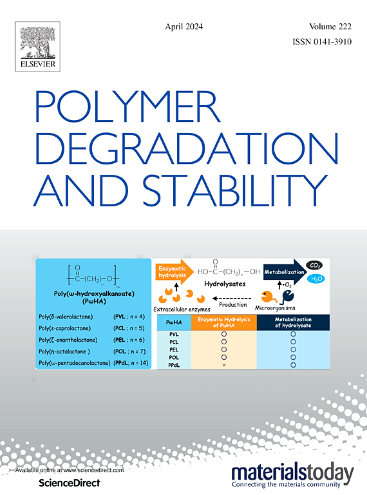Sustainable biocomposites based on Mater-Bi and grape pomace for a circular economy: Performance evaluation and degradation in soil
IF 6.3
2区 化学
Q1 POLYMER SCIENCE
引用次数: 0
Abstract
Biodegradable polymers often exhibit inferior properties and higher cost compared to their fossil-derived counterparts. The addition of plant waste and by-products can improve their performances, providing in the meantime functional activity and reducing their cost. In this work, we summarize the preparation of different biocomposites (BioCs) incorporating two diverse amounts (10 % and 20 %) of grape pomace (GP) in a Mater-Bi (MB) sample. GP, MB as well as BioCs were fully characterized. The influence of addition of GP on the properties and degradation in soil of the biocomposites was evaluated in comparison with the neat MB. However, natural antioxidants and other active compounds from GP could be sensitive to temperature. Thus, GP and MB underwent heat treatment at 180 °C to simulate and induce possible degradation during BioCs processing. GP analysis (particle size 50 μm) showed only a slight decrease of antioxidant potency, despite the heat treatment simulating the BioCs processing. 1H NMR of the MB soluble fraction in CDCl3 displayed the presence of two polymeric components: polylactide (PLA) and poly(butylene adipate-co-butylene terephthalate) (PBAT). Introduction of GP in the polymer matrix induced a proportional increase of antioxidant property in the BioCs as well as in complex viscosity at low frequencies. Moreover, a slight increase in the elastic modulus was observed with increasing the crystallinity of the samples. Degradation rate in soil, monitored by weight loss, increased with filler content and time. Moreover, NMR showed that, in the recovered sample after 45 days, the composition of PBAT changed, with the terephthalic percentage increased.

基于 Mater-Bi 和葡萄渣的可持续生物复合材料,促进循环经济:性能评估和在土壤中的降解
与化石衍生的聚合物相比,生物可降解聚合物通常性能较差,成本较高。添加植物废料和副产品可以改善其性能,同时提供功能活性并降低成本。在这项工作中,我们总结了不同生物复合材料(BioCs)的制备方法,在材料-生物(MB)样品中加入了两种不同数量(10 % 和 20 %)的葡萄渣(GP)。对 GP、MB 以及 BioCs 进行了全面表征。与纯甲基溴相比,评估了添加 GP 对生物复合材料特性和在土壤中降解的影响。然而,GP 中的天然抗氧化剂和其他活性化合物可能对温度敏感。因此,对 GP 和 MB 进行了 180 °C 的热处理,以模拟和诱导生物复合材料加工过程中可能发生的降解。对 GP(粒径为 50 μm)的分析表明,尽管进行了模拟 BioCs 加工的热处理,但其抗氧化效力仅略有下降。MB 可溶部分在 CDCl3 中的 1H NMR 显示存在两种聚合物成分:聚乳酸(PLA)和聚对苯二甲酸丁二醇酯(PBAT)。在聚合物基质中引入 GP 会诱导 BioCs 的抗氧化性和低频复合粘度成比例地增加。此外,随着样品结晶度的提高,弹性模量也略有增加。根据重量损失监测,土壤中的降解率随着填料含量和时间的增加而增加。此外,核磁共振显示,在 45 天后回收的样品中,PBAT 的成分发生了变化,对苯二甲酸的比例增加了。
本文章由计算机程序翻译,如有差异,请以英文原文为准。
求助全文
约1分钟内获得全文
求助全文
来源期刊

Polymer Degradation and Stability
化学-高分子科学
CiteScore
10.10
自引率
10.20%
发文量
325
审稿时长
23 days
期刊介绍:
Polymer Degradation and Stability deals with the degradation reactions and their control which are a major preoccupation of practitioners of the many and diverse aspects of modern polymer technology.
Deteriorative reactions occur during processing, when polymers are subjected to heat, oxygen and mechanical stress, and during the useful life of the materials when oxygen and sunlight are the most important degradative agencies. In more specialised applications, degradation may be induced by high energy radiation, ozone, atmospheric pollutants, mechanical stress, biological action, hydrolysis and many other influences. The mechanisms of these reactions and stabilisation processes must be understood if the technology and application of polymers are to continue to advance. The reporting of investigations of this kind is therefore a major function of this journal.
However there are also new developments in polymer technology in which degradation processes find positive applications. For example, photodegradable plastics are now available, the recycling of polymeric products will become increasingly important, degradation and combustion studies are involved in the definition of the fire hazards which are associated with polymeric materials and the microelectronics industry is vitally dependent upon polymer degradation in the manufacture of its circuitry. Polymer properties may also be improved by processes like curing and grafting, the chemistry of which can be closely related to that which causes physical deterioration in other circumstances.
 求助内容:
求助内容: 应助结果提醒方式:
应助结果提醒方式:


